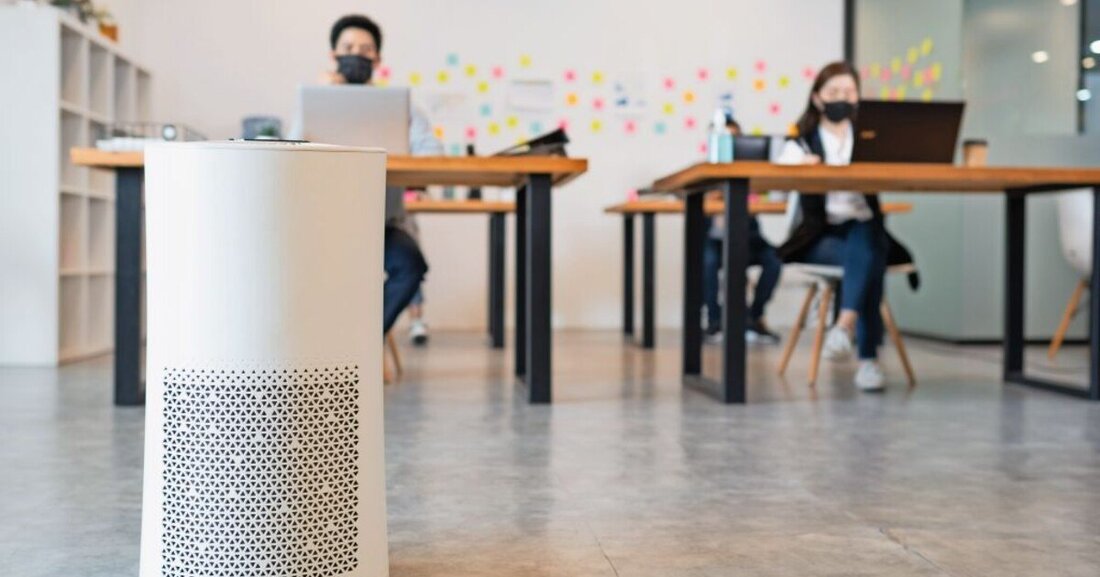Air filter against viruses
In closed rooms, airspace filters can reliably remove aerosols and viruses from the air. Sufficient dimensions and the right filter technology are crucial when purchasing.

Air filter against viruses
In closed rooms, viruses are the devil's work. Because nature has given viruses only one task: to multiply at the expense of their host. And that's what they like to do piggyback: aerosols are the airships of viruses. Docked to exhaled water droplets, they float from host to host. If you want to stop this disastrous journey, you have to show the droplets where the final destination is.
Clearly positive effects
Last fall, a team of scientists from Goethe University Frankfurt investigated a method of preventing the spread of aerosols in closed rooms: They installed four table-high air purifiers in a school class of 27 students - and analyzed their effect on aerosol pollution. The result: 30 minutes after switching on, the air purifier had removed 90 percent of the viruses from the air. The study was led by Professor of Experimental Atmospheric Research Joachim Curtius. He specifies his verdict: “The air purifiers clearly have positive effects in terms of aerosol filtration and virus cleaning in classroom-sized rooms.” Their effectiveness can be repeated in offices, workshops and showrooms alike.
Air purifiers have been on the market for a long time. However, their role as virus killers remained “pretty underexposed” until the Corona epidemic struck, as Peter Tappler admits. Tappler is a member of the “Indoor Air” working group in the German Federal Ministry for Climate Protection and co-managing director of the engineering firm IBO Innenanalytik. He has been studying indoor air pollution for decades. Tappler has no doubt that air purifiers reduce viral loads. But the devices are not a miracle cure: there is no 100 percent protection against infections with SARS-CoV-2. Therefore, air purifiers “could only be part of a functioning infection prevention system”.
● At the top of his list of recommendations is “natural ventilation through open windows”.
● Secondly, his warning “not to forego masks and distance in the rooms, despite all the use of technology”.
● Air purifiers correspond to Plan C. And it is best to pursue all three strategies at the same time.
When ventilation alone is not enough
The capabilities of the air purifiers must be appropriate for the size of the room. A frequently used measurement criterion is the “Clean Air Delivery Rate” (CADR) or “air throughput”: The CADR value indicates the volume of air that is cleaned of aerosols. It is measured in cubic meters per hour (m³/h). The Frankfurt study by Joachim Curtius recommends an air flow for professional use of “1,000 m³/h or more.”
Peter Tappler advises against always operating the devices near full load: “The closer the devices are operated to their performance limit, the louder they become.” Air purifiers should be set so that they only have to operate at a maximum of two-thirds of their capacity to deliver the necessary air flow. The performance has its price: costs start at 3,500 euros for a device.
So-called high-performance particulate air filters of filter classes H 13 and H 14 are suitable for use in rooms where several people are present (HEPA = High Efficiency Particulate Air Filter). They are able to effectively deal with SARS-CoV-2-laden particles. That's all you need: H 14 filters - they are intended for use in clean rooms and operating rooms - separate around 0.05% more particles compared to H 13 filters. Tappler: “This does not correspond to any hygienic advantage relevant to offices.”
Many devices also use techniques with ozone or cold plasma. This is intended to not only filter viruses, but also kill them. The Climate Protection Ministry advises against this because the side effects of the irritant gases have not been sufficiently tested. If you are unsure about selecting airspace filters, Peter Tappler can do so on his website www.innenraumanalytik.at contact.

 Suche
Suche
 Mein Konto
Mein Konto